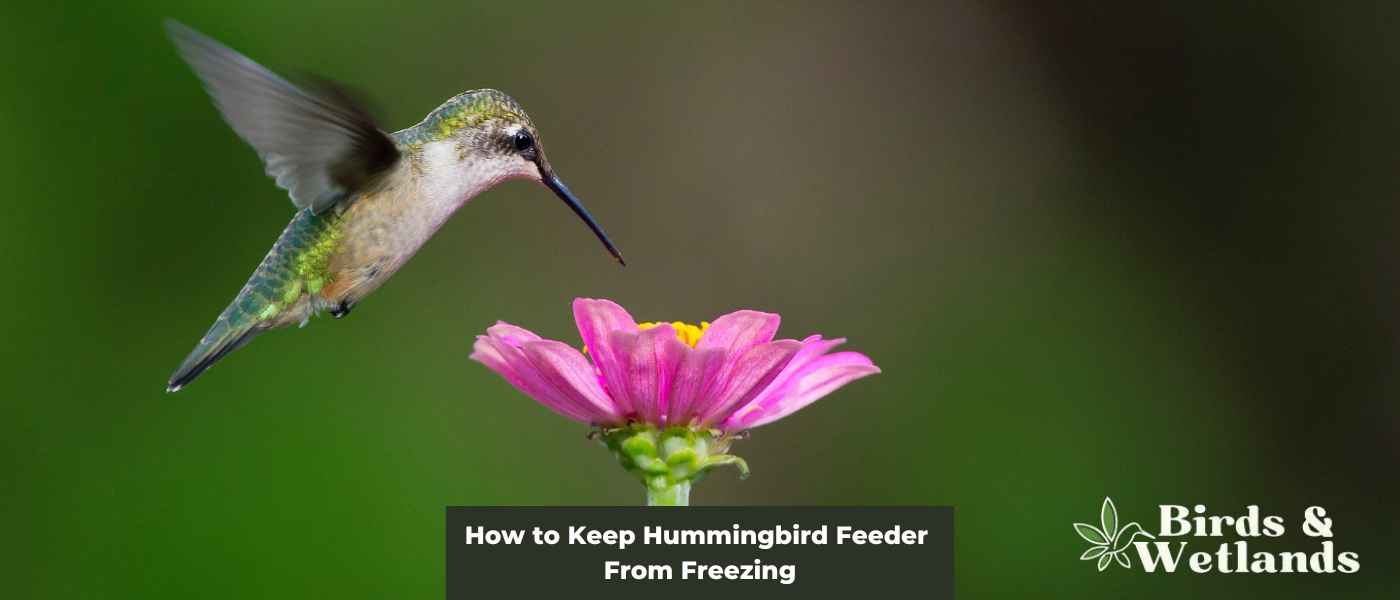To keep a hummingbird feeder from freezing, place it in a sheltered area away from the wind. Wrapping the feeder in insulating material can also help retain heat. Some people switch to a heated feeder or use a heat lamp or bird-safe outdoor heating pad to prevent freezing. Alternatively, bring the feeder inside at night and put it back out in the morning. Remember to check the nectar regularly to ensure it hasn’t frozen.
Key Takeaways on How to Keep Hummingbird Feeder From Freezing
How To keep hummingbird food from freezing Things to Consider
Keeping your hummingbird feeder from freezing during the cold winter months is crucial for those species of hummingbirds that overwinter. Here are some considerations and techniques to prevent your hummingbird feeder from freezing:
Remember, the safety and wellbeing of the birds come first. Any heating elements used should be safe and not able to harm the birds. And any changes in the nectar concentration should still be safe for the birds to consume. Hummingbirds need to maintain a very precise diet, so it is generally better to stick to the 4:1 water to sugar ratio whenever possible.
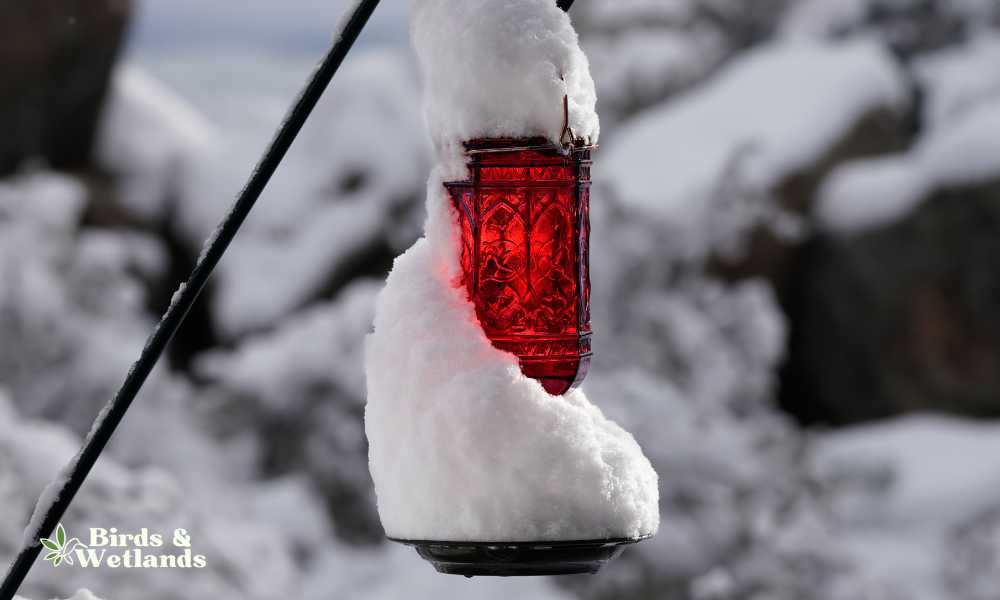
How do you keep hummingbird food warm in the winter?
Keeping hummingbird food warm in winter can be achieved through several methods. Using an insulated cover or a feeder designed with a built-in heater can prevent the nectar from freezing. Another method is to hang a low-wattage holiday light bulb near the feeder, generating enough heat to keep the nectar fluid. Bringing feeders indoors overnight and rehanging them at dawn can also help. However, always ensure to place your feeder in a sheltered spot away from wind and snow.
Use a heated hummingbird feeder.
Heated hummingbird feeders are designed to keep the nectar solution warm in colder temperatures and cold winds. These feeders usually have a built-in heater that warms the nectar, ensuring that it stays at a comfortable temperature for hummingbirds. Some models are powered by electricity, while others use solar panels.
Heating Hummingbird Feeder
The Perfect Winter Solution for Feeding Hummingbirds
- Winter Solution: Keep your hummingbird feeders functioning optimally in freezing temperatures, ensuring your hummingbirds are nourished.
- Simple and Effective: Utilizes a 15-watt incandescent light bulb to gently heat the nectar and prevent freezing.
- Premium Material: Features a trapezoidal design with a sealing ring for snow-proof operation, and durable, rigid plastic construction that is double the thickness of standard heaters.
Place the feeder in a sheltered location.
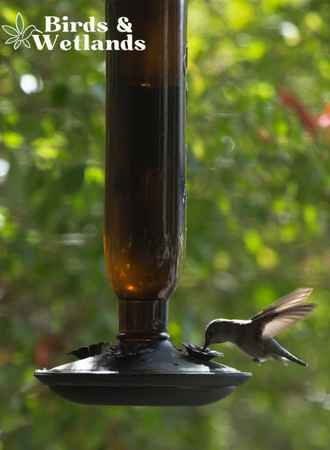
Hummingbird feeders placed in a sheltered location, such as covered porch or in a protected corner, can help keep the nectar warmer. By protecting the feeder from the wind and cold, the nectar can maintain a more stable temperature.
Wrap the feeder with insulation.
Wrapping the feeder with insulation, such as a foam sleeve or bubble wrap, can help keep the nectar warm. The insulation will act as a barrier between the feeder and the cold air, slowing the rate at which the nectar cools down.
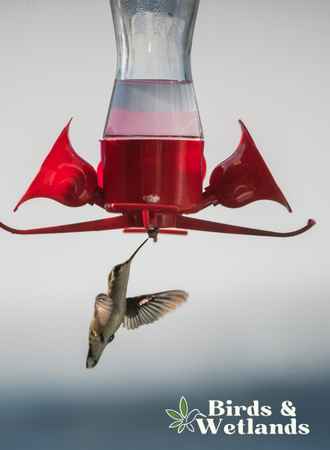
Bring hummingbird feeders indoors on cold night.
If you’re worried about the nectar freezing overnight, consider bringing the feeder indoors at night, especially in freezing weather. This will help keep the liquid nectar at room temperature and ensure that it’s ready for the hummingbirds in the morning.
Change the nectar frequently.
It’s important to change the nectar frequently, even in the winter. Fresh nectar is less likely to freeze than old nectar, and it’s also healthier for these tiny creatures. Be sure to clean the feeder thoroughly before refilling it with fresh nectar.
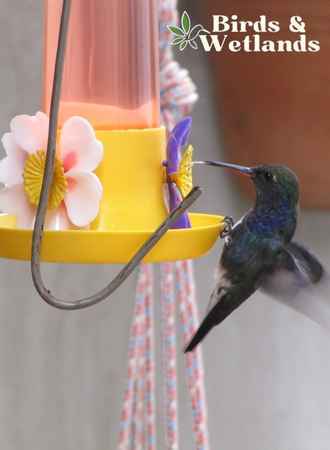
Wrapping hummingbird feeder with holiday lights.
While it’s true that Christmas lights can generate some heat and help prevent freezing, it’s generally not recommended to wrap them around hummingbird feeders. This is because hummingbird feeders are typically made of plastic or glass, and the heat generated by the lights can potentially cause the feeder to crack or melt, creating a safety hazard for the birds.
Wrapping the feeder with lights could make it more difficult to clean, as you would need to be careful not to damage the wires or bulbs while washing the feeder.
Using heat tape
It is possible to use plumber’s heat tape to keep hummingbird feeder nectar from freezing, but it is not recommended. Heating tape is designed to be used with metal or PVC pipes, and wrapping it around a plastic or glass feeder could potentially cause damage to the feeder or create a safety hazard for the birds.
There are specialized heating pads or blankets designed for use with bird feeders that are a better option. These products are designed to be safe for use with plastic or glass feeders, and are typically made with low-voltage heating elements that are safe for birds during freezing rain or in the bitter cold.
If you’re unable to find a specialized heating pad or blanket for your hummingbird feeder, you can try using a hand warmer or placing a small light bulb near the feeder to provide some heat and keep your feeder cozy. Be sure to monitor the feeder regularly and remove any ice or snow that may accumulate, as it can make it difficult or impossible for the birds to access the nectar.
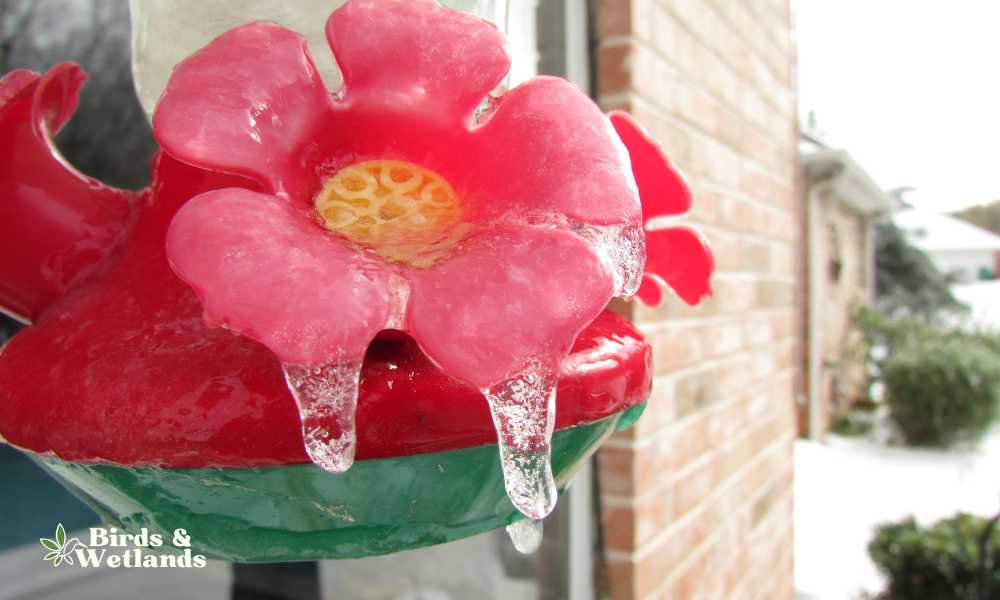
Can hummingbirds drink cold nectar?
Yes, hummingbirds can drink cold nectar. The temperature of the nectar does not pose a problem for hummingbirds as they are accustomed to consuming nectar from flowers which can be cool, especially in the early morning. However, it’s important to ensure that the nectar does not freeze in colder climates, as frozen nectar would be inaccessible for the hummingbirds to drink.
- Energy Consumption: Drinking cold nectar could potentially require more energy for a hummingbird, as they might need to expend additional energy to warm up. However, this energy expenditure is not typically significant enough to cause harm.
- Feeder Accessibility: If the nectar in the feeder is very cold, it may be more viscous (thick), which can make it slightly more difficult for hummingbirds to drink. Keeping the nectar at a temperature where it remains fluid is therefore key.
- Freezing Temperatures: If the weather is so cold that the nectar risks freezing, you will need to take steps to prevent this. A frozen feeder is inaccessible to birds and can potentially damage the feeder itself.
Hummingbirds are known for their high metabolism, which allows them to sustain their incredibly fast wing beats and active lifestyles. This metabolism also allows them to regulate their body temperature, keeping it at around 104 degrees Fahrenheit.
Because of this, they can tolerate a wide range of temperatures, including during harsh weather conditions. Regardless, a sudden cold snap can still be fatal to these little birds.
Nectar, on the other hand, is best when it is fresh and at room temperature. If nectar is kept in a feeder outside, it can become chilled in colder weather or in the shade. While hummingbirds can drink this chilled nectar, it may not be as attractive to them as fresh, warm nectar.
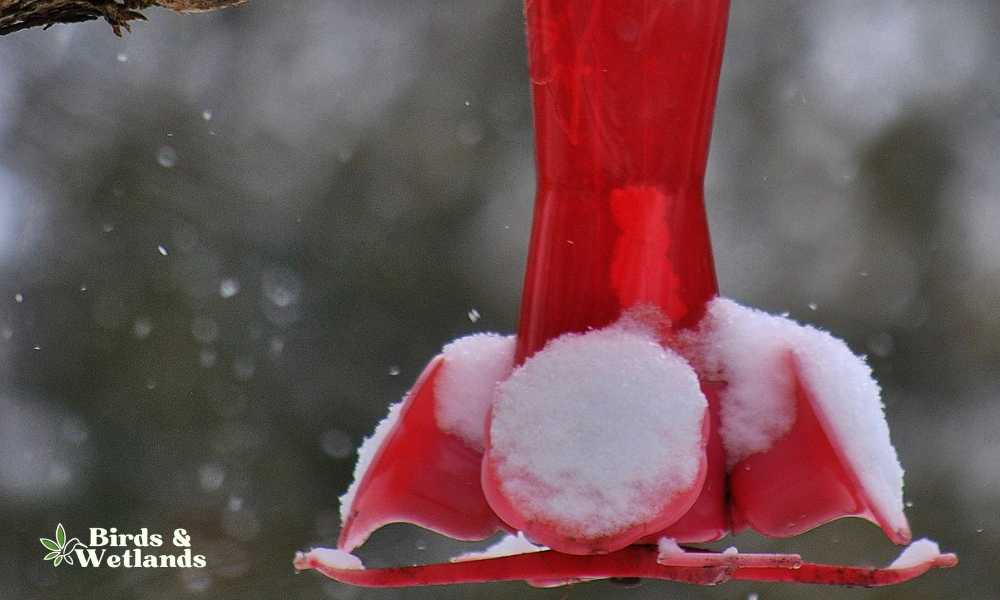
How to thaw frozen hummingbird feeders
Thawing frozen hummingbird feeders is a fairly simple process. Here are the steps you can take:
- Remove the frozen feeder from its hanging location and bring it indoors. This will allow you to work on thawing the feeder in a warm environment.
- Submerge the feeder in warm water. You can fill a sink or a container with warm water and place the feeder inside, or you can hold the feeder under a stream of warm water in your kitchen sink. Make sure that the water is warm but not hot, as hot water can potentially damage the feeder or cause it to crack.
- Gently agitate the feeder. You can use a gentle back-and-forth motion to help the water circulate around the feeder and speed up the thawing process. Be careful not to shake or jostle the feeder too vigorously, as this can potentially damage it.
- Test the feeder periodically and make sure that feeding ports or feeder ports remain unobstructed. After a few minutes, check the feeder to see if the nectar or hummingbird sugar water has started to thaw. You can test this by gently shaking the feeder to see if the nectar is no longer frozen solid and moves or pours out. If the nectar is still frozen, continue to soak and agitate the feeder until it thaws completely.
- Refill the feeder and hang it back up. Once the nectar is thawed, you can refill the feeder and hang it back up in its usual location. Be sure to monitor the feeder regularly to make sure that the nectar does not freeze again. If the weather is extremely cold, you may need to take additional steps to keep the nectar from freezing, such as using a heating pad or moving the feeder to a warmer location.
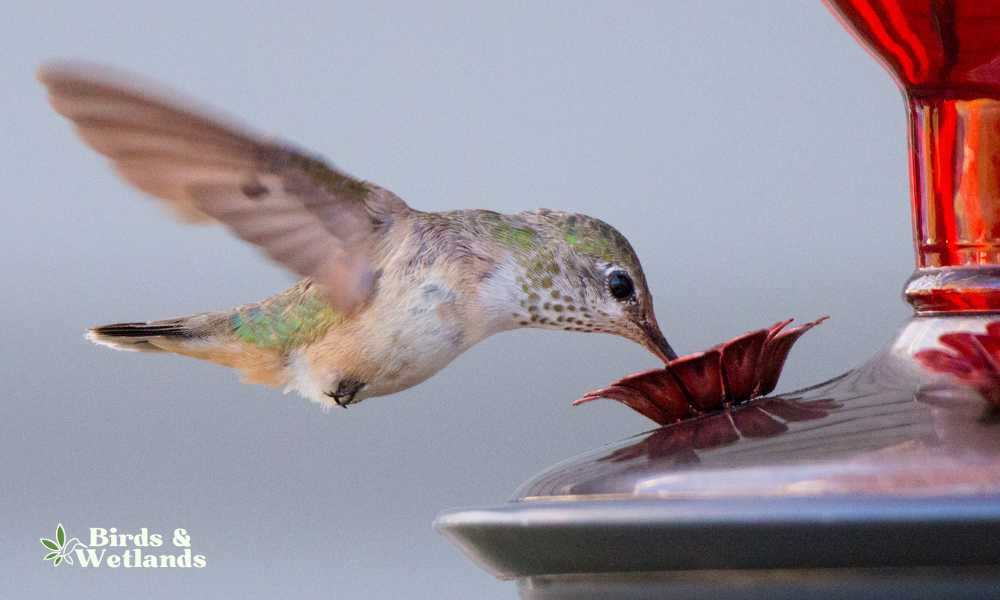
How do you make a hummingbird warming station?
Creating a warming station for hummingbirds during colder temperatures can help attract these tiny creatures to your yard and keep them comfortable. Here’s a simple guide on how to make a hummingbird warming station:
Materials:
- Hummingbird feeder
- Safe outdoor lights (like Christmas lights)
- Extension cord
Steps:
- Choose the Right Spot: Locate your feeder in a place protected from wind but where it can get some morning sunlight. This can help keep the nectar from freezing. Remember to keep it at least 5 feet from the ground to protect hummingbirds from predators.
- Wrap the Feeder with Lights: Wrap a string of safe outdoor lights around the hummingbird feeder. LED lights are not recommended because they don’t generate enough heat. Traditional, low-energy holiday lights could be an option.
- Connect to a Power Source: Run an outdoor extension cord to the lights, making sure to secure the cord safely out of the way so it’s not a tripping hazard. It’s important to ensure the lights, cords, and connections are suitable for outdoor use and weather-resistant.
- Switch on the Lights: When the temperature drops, turn on the lights. The warmth from the lights should help keep the nectar from freezing. Monitor the setup regularly to ensure it’s working properly and safely.
Remember, this setup is intended to keep the nectar from freezing, not to make it warm. The bulbs should be low wattage to avoid overheating the feeder which could potentially harm the birds.
Additional Tips on Keeping Hummingbird Feeders Warm
Here are additional tips on feeding hummingbirds in winter:
- Don’t place heated lamps or lights near your plastic feeders. Otherwise, they will melt.
- Always keep your hummingbird nectar fresh, especially for overwintering hummingbirds such as Anna’s hummingbirds.
- Keep in mind that any solution from keeping your nectar feeder from freezing can also result in the nectar going bad quickly.
- Take note when hummingbirds feed, which is usually during daylight hours.
- Window feeders may not necessarily be better at keeping nectar from freezing in winter, but you can place them in a warmer location that takes advantage of the heat from your home.
- Changing the nectar ratio during cold weather can help it remain liquid or make a solution with a slightly lower freezing point. However, keep in mind that adding more sugar into the solution is not good for hummingbirds.
- Make sure your feeders have small perches underneath so that hummingbirds can rest.
- Another idea is to use duct tape and hand warmers around the feeders to generate enough heat.
- Since incandescent bulbs are obsolete, using LED lights to provide enough warmth during snowy weather or on coldest nights is a good alternative.
- Having two feeders or several feeders instead of one feeder can help ensure that there’s an adequate supply or enough nectar for visitors and other hummingbirds.

